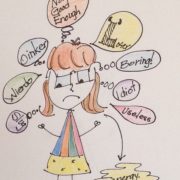Your OCD thoughts (Obsessive Compulsive Disorder) are false alarms, and you have to treat them as such. What research from Dr. Jeffrey M. Schwartz, UCLA School of Medicine shows: Bio-behavioral treatment works for retraining the brain that is stuck in OCD thought patterns. It’s not easy, but it is longer lasting and more permanently effective than relying on what he calls the “water wings” approach to treatment—that is meds only. There is no medication on the planet that will retrain your brain. Schwartz describes doing this training in the four steps below.
There is no medication on the planet that will retrain your brain.

Four Steps
The 4 Steps
- Relabel: Increasing your awareness that your thoughts, when they interfere with how you want to live your life, are SYMPTOMS of a medical disorder. In my opinion, a problem is not a problem, until it is one! This is when, at times, thoughts appear as intrusive thoughts and urges you feel you cannot control. Start labeling them as obsessions and compulsions, with little basis in reality, as the false alarms they really are. The goal is to control your responses to the thoughts, not the thoughts themselves.
- Reattribute: “It’s not me, it’s my OCD!” (It even rhymes, which may or may not be helpful.) In the brain is a structure called the caudate nucleus. Together with its sister structure, the putamen, they act like an automatic transmission in a car in a regular brain. They control the many shifts you make daily between controlling body movement, physical feelings, and the thinking and planning that involve those movements. It is the shift that is out of whack with the OCD brain. You have a brain version of a sticky manual transmission. It takes you an inordinate amount of work to shift thoughts smoothly. This is due to a glitch in the caudate nucleus, which has been demonstrated repeatedly via PET scans of brains with OCD. Also, your orbital cortex, the front part of your brain, has an error detection circuit, which becomes stuck in gear. This is the reason that feeling that “something is wrong” will not go away. So the key here is to note that the feeling and the thoughts are a medical condition that will cause you to have to shift manually. When you do this, you actually begin to change your own brain chemistry.
- Refocus: This is the toughest step by far—the “no pain, no gain” step. With effort and mindfulness you are going to do what the caudate nucleus normally does easily. How? Hobbies are particularly good. You can also take a walk, listen to music, exercise, read, play a computer game, knit, shoot a basketball, etc. The key: Do anything pleasant and constructive. This also involves incorporating delays. They must be anywhere from 15 seconds to 15 minutes, gradually getting longer and longer BEFORE you engage in the compulsive behavior. During the delay, you engage in the other pleasant activity, and after that reassess the urge.You evaluate it and acknowledge that this time it overwhelmed you, and try the next time. Ex: “I’m not washing my hands because they are dirty, I’m washing them due to my OCD.”
IMPERATIVES:
- Don’t wait for the thought or feeling to go away.
- Don’t expect it to go away right away.
- Don’t do what your OCD is telling you to do.
4. Revalue: So you are working #1 and #2 together, along with #3-which is the step where you are relearning and reevaluating your thoughts. As a result, you begin to be able to learn to place a much lower value on your thoughts and urges, dismissing them the majority of the time. How long does this take? Using the idea of an impartial spectator inside of you, that you carry around at all times, you begin to get the necessary distance required to place your thoughts in context— as functions of your sticky manual transmission. Anticipation and acceptance of your thoughts = active revaluing.
If you have trouble with sticky OCD thoughts, contact me here. We can work in person or online to start retraining your brain into a healthier pattern. Please remember that your OCD thoughts are false alarms, and that this is tough work. You have to want the change enough to want the work that comes with achieving it.
Resource: Brainlock, Jeffrey M. Schwartz, M.D., 1996, Harper Collins











